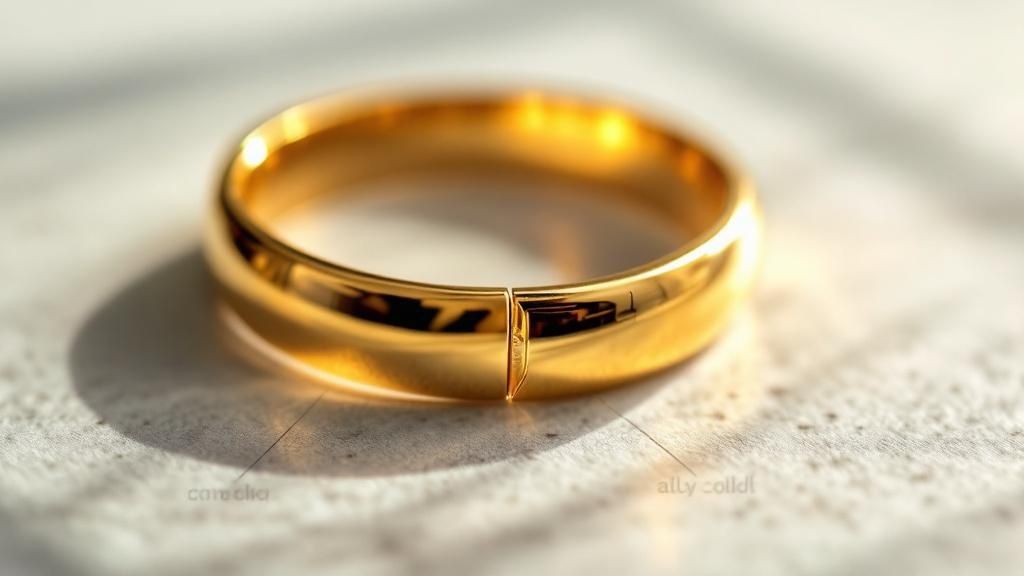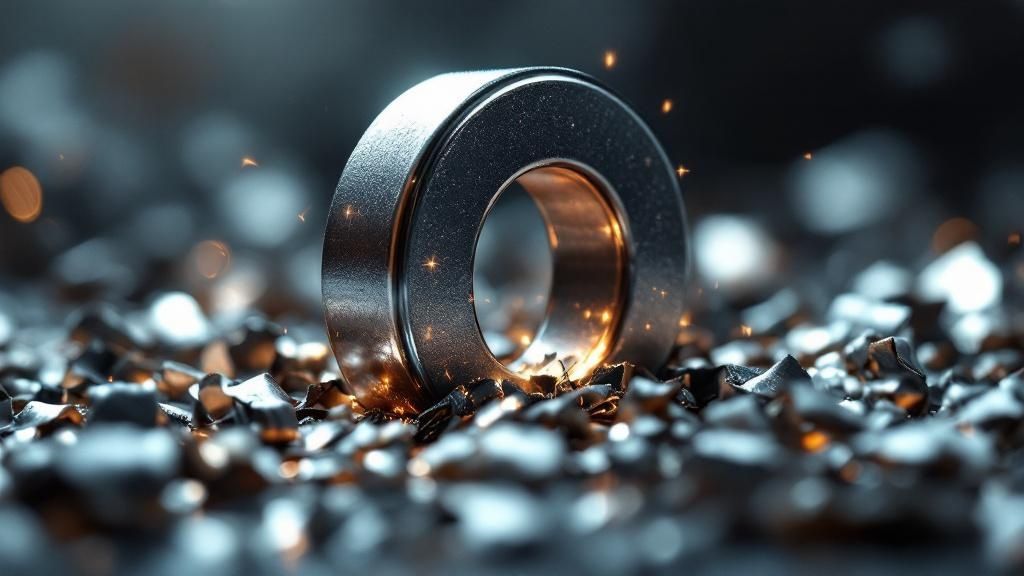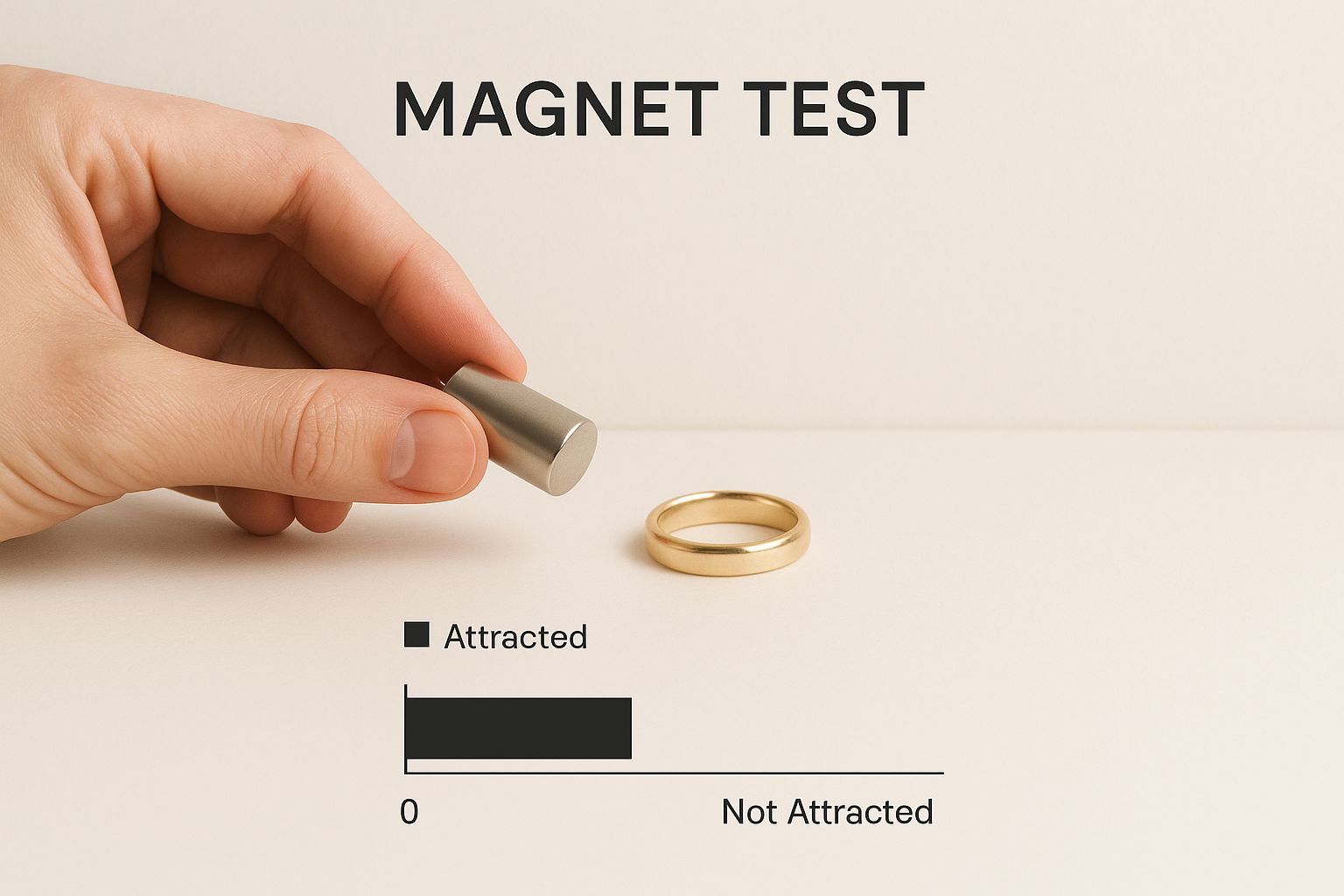Is 14k Gold Magnetic? A Simple Guide to Testing Jewelry
- Luke Zucco
- Aug 15
- 10 min read
So, is 14k gold magnetic? The short answer is: sometimes, just a little. While pure, 24-karat gold has zero magnetic attraction, 14k gold is a different story.
Think of it this way: 14k gold isn't pure gold. It's an alloy, which means only 58.3% of it is gold. The rest is a mix of other metals added to give it strength and durability. If that mix includes magnetic metals like nickel or iron, you'll feel a slight pull from a magnet.
Why Your 14k Gold Might Stick to a Magnet

That "14k" stamp on your jewelry is a promise: 14 parts out of 24 are pure, unadulterated gold. The remaining 10 parts—making up 41.7% of the piece's total weight—are the other metals. These alloy metals are what give the jewelry its final color, hardness, and, you guessed it, its magnetic properties.
It's a bit like baking. The pure gold is your flour, but the other ingredients you mix in—like sugar, butter, or spices—completely change the outcome. A jeweler does the same thing, just with metals instead of pantry staples.
The Role of Alloy Metals
The specific metals blended into the gold are the real culprits behind any magnetic attraction. Some recipes result in a totally non-magnetic piece, while others create a slight magnetic response.
Here’s how it usually plays out:
Yellow and Rose Gold: These classic colors are typically made by mixing gold with non-magnetic metals like copper and silver. Because of this, you can almost bet that your 14k yellow or rose gold won't react to a magnet at all.
White Gold: This is where things get interesting. To get that bright, silvery-white sheen, jewelers often use nickel in the alloy. Nickel is strongly magnetic, so it’s actually quite common for 14k white gold to show a weak pull.
If your white gold has a faint magnetic pull, don't panic! It’s often a good sign, confirming it contains the nickel expected in its alloy rather than indicating it's fake.
To make this even clearer, here's a quick reference guide.
Quick Guide to Gold Purity and Magnetic Attraction
This table breaks down how common metals used in jewelry react to a magnet.
Material | Magnetic Property | Primary Reason |
|---|---|---|
24k Pure Gold | Non-magnetic | Gold itself is not a magnetic metal. |
14k Yellow Gold | Non-magnetic | Typically alloyed with non-magnetic copper and silver. |
14k Rose Gold | Non-magnetic | The high copper content is non-magnetic. |
14k White Gold | Slightly Magnetic | Often contains nickel, which is a magnetic metal. |
Gold-Plated Items | Can be Strongly Magnetic | The base metal underneath (like iron or steel) is often magnetic. |
As you can see, the type of gold and the metals it's mixed with make all the difference.
Why Pure Gold Never Sticks to a Magnet

To really get to the bottom of why your 14k gold might have a pull to it, we need to start with the real thing: pure, 24k gold. Pure gold is, for all intents and purposes, completely indifferent to magnets.
In scientific circles, this property is known as diamagnetism. It’s the exact opposite of what we think of as magnetic attraction.
Instead of being pulled in by a magnetic field, diamagnetic materials are actually repelled by it—just a tiny, tiny bit. Think about the feeling you get when you try to push the same ends of two magnets together. That slight, invisible pushback is a perfect way to picture how pure gold reacts. It's an incredibly faint effect, so you'd never feel it with a regular kitchen magnet.
The bottom line is simple: pure, 24k gold will never, ever stick to a magnet. If you feel any magnetic pull from your gold jewelry, it’s coming from the other metals in the alloy, not the gold itself.
This little piece of science is the foundation for testing your jewelry at home.
The Science Behind Gold's Magnetic Nature
The "why" behind all this comes down to gold's atomic structure. Scientists classify pure gold as diamagnetic, giving it a magnetic susceptibility score of -3.44 × 10⁻⁵. That negative number is the scientific proof that it weakly pushes away from magnetic fields instead of being drawn to them.
This is a crucial concept to grasp because it shows how the metals mixed with gold can totally change its behavior. Adding other metals, or alloys, doesn't just change the color and durability of your jewelry; it can also introduce unexpected traits like magnetism. You can learn more about how these alloys affect your jewelry in our guide on [if 14k gold tarnishes and how to prevent it](https://www.pantherdeluxe.com/post/does-14k-gold-tarnish-and-how-can-you-stop-it).
Knowing this baseline helps you understand what's really going on when you put a magnet to your favorite ring or chain.
How Alloy Metals Determine if Your Gold Is Magnetic
When you see "14k" stamped on a piece of jewelry, think of it less as a statement of purity and more like a recipe. It tells you the item is 58.3% pure gold, with the remaining 41.7% being a mix of other metals, which we call alloys. These alloys are the real workhorses in the jewelry world.
They're added to give gold the strength it needs to survive daily wear and tear, turning a soft metal into durable rings and bracelets. Alloys are also the secret behind the beautiful colors we see—from the warm glow of yellow gold to the blush of rose gold and the cool shine of white gold. And, crucially for our magnet test, each of these metals has its own magnetic properties.
The Culprits Behind the Pull
So, what makes a piece of 14k gold stick to a magnet? It all comes down to the specific metals mixed in with the gold. Some of the most popular alloys couldn't care less about a magnet, while others will definitely react.
Copper and Silver: These are the classic partners for creating yellow and rose gold. Luckily for us, both are non-magnetic. That means most 14k yellow or rose gold jewelry won't show any reaction.
Zinc: Another common, non-magnetic metal, zinc is often added in smaller quantities to the mix.
Nickel: Here's our prime suspect. Nickel is a go-to for making white gold look so bright and silvery, and it adds a ton of hardness. But nickel is also ferromagnetic—a fancy way of saying it’s magnetic—so 14k white gold will often have a noticeable, albeit slight, pull.
You can see a magnet test being performed on a 14k gold ring in the image below.

This simple test illustrates how the presence of specific alloys can cause a reaction that pure gold just wouldn't have.
To give you a clearer picture, let's break down which metals are doing what inside your jewelry.
Magnetic Properties of Common 14k Gold Alloys
Alloy Metal | Common Use in Gold | Is It Magnetic? | Effect on 14k Gold |
|---|---|---|---|
Copper | Yellow Gold, Rose Gold | No | Keeps the alloy non-magnetic. |
Silver | Yellow Gold, White Gold | No | Keeps the alloy non-magnetic. |
Nickel | White Gold | Yes (Ferromagnetic) | Causes a slight magnetic pull. |
Palladium | White Gold | No | Creates a high-quality, non-magnetic white gold. |
Zinc | Yellow Gold, White Gold | No | Used as a deoxidizer; keeps the alloy non-magnetic. |
This table shows why your 14k white gold ring might be attracted to a magnet while your 14k yellow gold chain isn't. It's all about the nickel.
Because copper and silver are so common, most yellow and rose gold pieces you come across will be non-magnetic. But that faint pull you might feel from white gold is often a totally normal characteristic, not a red flag for a fake.
Key Takeaway: A slight magnetic pull in 14k gold, especially white gold, can actually be a good sign. It points to the presence of common alloys like nickel, not necessarily a counterfeit. If you're ever in doubt about your jewelry's authenticity or value, getting a professional appraisal is always the smartest move. You can learn more in our complete guide to jewelry appraisal costs.
So, How Do You Test Your Own Jewelry with a Magnet?
Ready to do a little treasure hunting in your own jewelry box? Using a magnet is a super simple, quick way to get a better idea of what your gold is made of. It's a great first pass to spot obvious fakes and understand why your genuine 14k pieces might be behaving a certain way.
First things first, you'll need the right kind of magnet. The ones holding up postcards on your fridge won't cut it. You need something with a bit more oomph, like a neodymium magnet. You can easily find these at any hardware store, and their strong magnetic field is exactly what you need to pick up on the subtle pull from certain metal alloys.
The test itself is dead simple. Just hold your jewelry steady and bring the magnet right up to it. Let them touch.
Now, pay close attention. What happens? Does the jewelry just sit there, completely unimpressed? Or do you feel a tiny, almost hesitant pull? Maybe it jumps right out of your hand and clamps onto the magnet. Each reaction is a clue.
Reading the Results
That little feeling—or lack thereof—is where the story is. Understanding what the reaction means will tell you whether your 14k gold is magnetic for all the right reasons.
Here’s a quick guide to what you might find:
No Reaction at All: This is a fantastic sign! If your jewelry completely ignores the magnet, it's very likely genuine 14k yellow or rose gold. The alloys used, like copper and silver, aren't magnetic.
A Faint, Gentle Tug: Feel a slight pull? Don't panic, especially if you're testing white gold. This weak attraction is a classic sign that your 14k gold contains nickel, the magnetic alloy that gives white gold its signature color.
A Strong, Obvious Pull: This is the big red flag. If your jewelry snaps right to the magnet and holds on tight, you're almost certainly dealing with gold-plated costume jewelry. The powerful attraction comes from a core of a highly magnetic metal like iron or steel hiding underneath a thin gold wash.
Keep in mind: The magnet test is a great screening tool, but it's not the final word. Some clever fakes are made with non-magnetic base metals. For total peace of mind, it’s always best to combine this with other tests for gold authenticity.
So, What Do Your Magnet Test Results Mean?
After you’ve brought a magnet up to your jewelry, the reaction you get—or don't get—is telling you a story. But it’s important to see this test for what it is: a quick first pass, not the final word on authenticity. Let's break down what each outcome really means.
A faint, gentle pull is probably the most confusing result you can get. Surprisingly, this is completely normal for some genuine 14k gold pieces. This subtle attraction is almost always caused by nickel in the alloy, a common and perfectly standard ingredient used to give white gold its silvery color. So, don't panic if you feel a weak tug—it's often just a clue that you're holding authentic 14k white gold.
Decoding the Different Reactions
What if there’s no reaction at all? That’s a fantastic sign. The primary metals mixed into 14k yellow and rose gold are typically non-magnetic, like copper and silver. A total lack of interest from the magnet strongly suggests your piece is made from one of these traditional, non-magnetic gold alloys.
On the other hand, a strong, decisive snap to the magnet is exactly what you don't want to see.
A powerful magnetic pull is a huge red flag. It almost certainly means the item is made from a cheap, highly magnetic base metal like iron or steel, with just a paper-thin layer of gold plating on top. Real 14k gold is never strongly magnetic.
Here’s a simple way to think about the results:
No Reaction: You're very likely looking at real 14k yellow or rose gold.
Weak Attraction: Good chance it's real 14k white gold that contains nickel.
Strong Attraction: It’s almost certainly fake or just gold-plated.
This quick magnet check is a great way to sort your pieces, but if you have a valuable item you need to be sure about, nothing beats getting a professional opinion.
Looking Beyond the Magnet Test: How to Be Sure It's Real Gold
So, the magnet test is a great starting point, but it's definitely not the end of the story. Think of it as a quick screening. Smart counterfeiters know all about this trick and often use non-magnetic metals like brass or copper to create fakes that will fool a magnet every time.
To really get to the bottom of it, you'll need to dig a little deeper.
The simplest next step is to play detective and look for official hallmarks. These are tiny stamps pressed into the gold, usually hidden away on the clasp of a necklace or the inside of a ring. They’re the manufacturer's guarantee of purity.
You're looking for marks like '14k' (for 14 karat) or the European equivalent, '585', which tells you the piece is 58.3% pure gold. If you can't find a stamp, it doesn't automatically mean it's fake, but it's a big red flag that calls for a closer look.
Getting a More Definitive Answer
If you want to be more certain without leaving your house, there are other tests you can try. But let's be honest—for 100% certainty, nothing beats a professional's opinion.
The Specific Gravity Test: This is a bit more involved but much more reliable than the magnet test. It involves using water and a precise scale to measure your jewelry's density. Real gold has a very specific density, which is hard to fake.
Take It to a Pro: For ultimate peace of mind, your best bet is to visit a jeweler you trust. They have specialized equipment that can analyze the exact metal makeup of your jewelry without leaving a scratch.
A professional can use things like an acid test or an X-ray fluorescence (XRF) scanner to give you an undisputed verdict. To see a full breakdown of all the ways you can check your jewelry, check out our complete guide on [how to tell real gold from fake](https://www.pantherdeluxe.com/post/how-to-tell-real-gold-from-fake-top-methods-to-identify-genuine-gold). Ultimately, professional verification is the only way to be absolutely sure.
Common Questions About 14k Gold and Magnets
So you've done the magnet test, but the results might have left you with more questions than answers. That's perfectly normal. Let's walk through a couple of common situations that can be confusing at first glance.
"My 14k White Gold Is Magnetic. Is It Fake?"
This is a great question, and the answer is almost always no—it's likely very real.
To get that classic bright, silvery-white look, jewelers often mix pure gold with other metals, and one of the most common is nickel. Because nickel is a magnetic metal, it's completely normal for 14k white gold to show a slight pull from a powerful magnet. It's just a sign of the alloy, not a sign of a fake.
"Should a 14k Gold Chain Stick to a Magnet?"
Here's another tricky one. The chain itself? No. The clasp? Probably.
Most jewelry clasps, especially spring rings or lobster clasps, have a tiny steel spring inside them. That spring is what gives the clasp its "snap" and keeps it secure. Since steel is very magnetic, you'll often find that only the clasp of your chain sticks to the magnet, while the links don't react at all. This is actually a good sign.
A magnetic clasp is often a feature, not a flaw. The weak steel spring is necessary for the mechanism to work properly, while the rest of the chain remains non-magnetic, as expected for genuine 14k gold.
At Panther De Luxe Shop, we believe in quality you can trust. Explore our collection of certified 14k and 18k gold jewelry to find your next timeless piece. Visit us at https://www.pantherdeluxe.com.

Comments